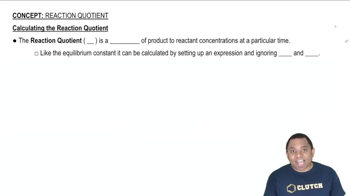(a) If Qc > Kc, how must the reaction proceed to reach equilibrium?
As shown in Table 15.2, Kp for the equilibrium N2(g) + 3 H2(g) ⇌ 2 NH3(g) is 4.51 * 10^-5 at 450 _x001F_C. For each of the mixtures listed here, indicate whether the mixture is at equilibrium at 450 _x001F_C. If it is not at equilibrium, indicate the direction (toward product or toward reactants) in which the mixture must shift to achieve equilibrium. (a) 98 atm NH3, 45 atm N2, 55 atm H2. (b) 57 atm NH3, 143 atm N2, no H2. (c) 13 atm NH3, 27 atm N2, 82 atm H2.
 Verified step by step guidance
Verified step by step guidanceKey Concepts
Equilibrium Constant (Kp)

Le Chatelier's Principle

Reaction Quotient (Q)

(b) At the start of a certain reaction, only reactants are present; no products have been formed. What is the value of Qc at this point in the reaction?
At 100°C, the equilibrium constant for the reaction COCl2(𝑔) ⇌ CO(𝑔) + Cl2(𝑔) has the value 𝐾𝑐 = 2.19×10−10. Are the following mixtures of COCl2, CO, and Cl2 at 100°C at equilibrium? If not, indicate the direction that the reaction must proceed to achieve equilibrium.
(a) [COCl2] = 2.00×10−3 M, [CO] = 3.3×10−6 M, [Cl2] = 6.62×10−6 M
(b) [COCl2] = 4.50×10−2 M, [CO] = 1.1×10−7 M, [Cl2] = 2.25×10−6 M
(c) [COCl2] = 0.0100 M, [CO] = [Cl2] = 1.48×10−6 M
At 900 K, the following reaction has 𝐾𝑝 = 0.345: 2 SO2(𝑔) + O2(𝑔) ⇌ 2 SO3(𝑔) In an equilibrium mixture the partial pressures of SO2 and O2 are 0.135 atm and 0.455 atm, respectively. What is the equilibrium partial pressure of SO3 in the mixture?
